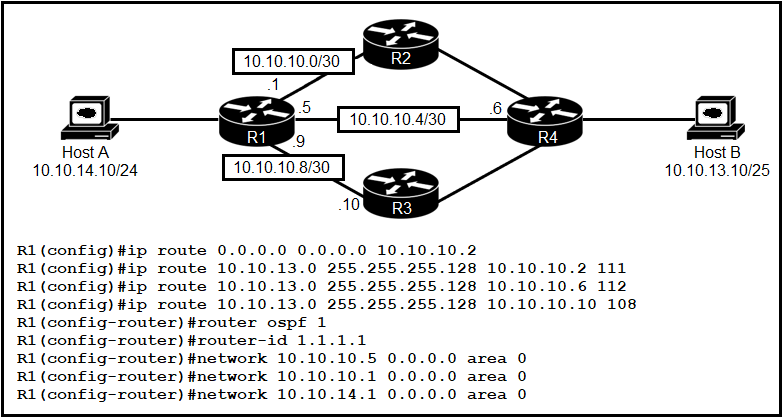
Refer to the exhibit. R1 has just received a packet from host A that is destined to host B. Which route in the routing table is used by R1 to reach host B?

Refer to the exhibit. R1 has just received a packet from host A that is destined to host B. Which route in the routing table is used by R1 to reach host B?
When a router receives a packet, it uses the route with the longest prefix match in its routing table to forward the packet. In this scenario, the relevant routes to the destination host B (10.10.13.10) are those for the network 10.10.13.0/25. Among the options provided, there are multiple routes to this subnet, but R1 will prefer the one with the lowest administrative distance. The route with the lowest administrative distance (AD) is 10.10.13.0/25 [108/0] via 10.10.10.10, which has an AD of 108. Thus, the correct route is the one with the AD of 108, leading to 10.10.10.10.
B is correct; it uses the lowest AD out of all the routes presented that go to the 10.10.13.0/25 subnet. A is a default route and would only be used if there wasn't a route to that subnet in the routing table.
A is not listed in the routing table Based on the default route entry configured on R1 from the exhibit, a default route would look like this: 0.0.0.0/0 [1/0] via 10.10.10.2 B is a valid entry + it has the lowest AD (given that all route entries have the same prefix length)
Longest prefix match is preferred over any AD value. Here, although the default route uses AD of 1 ,it isn't the proper match for the destination. Destination address is 10.10.13.10 and the longest prefix match for that is 10.10.13.0/25. There are currently 3 routes configured for that destination each with different AD value and also OSPF is running. Now when you first have the longest prefix match then only you check the AD value. So that would make the route with AD of 108 the perfect path for the destination. Router make decision based on the following checklist in order. 1. Longest prefix match 2. AD 3. Metric This is just a high level overview but for the CCNA I think this will suffice.
Default routes are only used when there's no route in the routing table that matches our destination.
OSFP routing, indicated by area 0 routing command, has AD of 110. There is a floating static route configured with 108 AD. As the configured static route's AD is lower (108) than the OSPF's default AD (110) it will route the traffic via 10.10.10.10 because it has the lowest AD and thus will be put into the routing table.
what a question, first you might think it's the route with the lowest AD value, then when you see the conf you realise it's a default route and only used when there is no matching route
Choice B coz it has lowest AD and it is the most specific one
It´s B
A is not even listed in the routing table. B is a valid route in the routing table and it is the one with the lowest AD , therefore; it will be used to reach host B
router will always trust you more than any routing protocols. the answer is A.
Since the network 10.10.10.8/30 is not advertised in the OSPF configuration and there is no specific route to 10.10.10.10 in the routing table, R1 wouldn't have a direct route to reach 10.10.10.10. In this scenario, R1 would typically follow the default behavior of selecting the best match in its routing table. The best match among the routes listed would be the default route
R1 sees 10.10.10.10 directly since they are in the same network (10.10.10.8/30). Correct answer is B.
A default route is a route that takes effect when no other route is available for an IP destination address. In our case, we have a route that matches the destination and thus the default route won't be used. The correct answer is B
Route Source Default Distance Values Connected interface 0 Static route 1 Enhanced Interior Gateway Routing Protocol (EIGRP) summary route 5 External Border Gateway Protocol (BGP) 20 Internal EIGRP 90 IGRP 100 OSPF 110 Intermediate System-to-Intermediate System (IS-IS) 115 Routing Information Protocol (RIP) 120 Exterior Gateway Protocol (EGP) 140 On Demand Routing (ODR) 160 External EIGRP 170 Internal BGP 200 Unknown* 255
Very tricky haha
B is correct
B is correct
Just so blooming sneaky isn't it. You think you are getting it and it seems like you are not as there are just so many tricky/ trap questions. So read the questions fully and make sure you are aware of the keywords in the question. If choice 'A' was in the routing table, that would be the route used. However it is not so the answer is B!
AD in option A must be 111 not 1!!!
B. Static rout with lowest AD takes precedence over default route.
different routing protocol to the same destination will be selected by AD so the answer is B